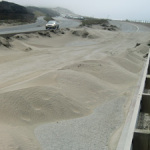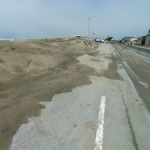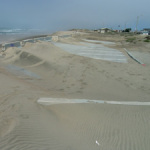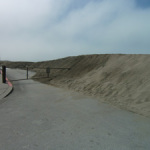 A report entitled Sea-Level Rise: a Slow-Moving Emergency, was released in August 2014 by the Assembly Select Committee on Sea Level Rise and the California Economy. The Select Committee, established in 2013 and chaired by state Assemblyman Richard Gordon, D-Menlo Park, held four hearings throughout the state to examine sea-level rise’s effect on various sectors and industries. Topics at the four hearings included projected impacts on coastal agriculture, the fishing and aquaculture industry, tourism, ports, roads and bridges, and water and power infrastructure. The Committee also examined the existing authority granted to state agencies in regards to preparedness and response to anticipated sea-level rise.
A report entitled Sea-Level Rise: a Slow-Moving Emergency, was released in August 2014 by the Assembly Select Committee on Sea Level Rise and the California Economy. The Select Committee, established in 2013 and chaired by state Assemblyman Richard Gordon, D-Menlo Park, held four hearings throughout the state to examine sea-level rise’s effect on various sectors and industries. Topics at the four hearings included projected impacts on coastal agriculture, the fishing and aquaculture industry, tourism, ports, roads and bridges, and water and power infrastructure. The Committee also examined the existing authority granted to state agencies in regards to preparedness and response to anticipated sea-level rise.
The report highlighted data from the nation’s longest continuously operating gauge of sea level, at Fort Point in San Francisco Bay, which recorded a seven-inch rise in the local sea level over the 20th century. Here are a few highlights from the four hearings:
Dr. Gary Griggs, Distinguished Professor of Earth Sciences and Director of the Institute of Marine Sciences, University of California Santa Cruz, said that in the short-term, tsunamis can raise sea levels fifty feet or more over minutes in coastal areas. Tides which go in and out every day also can change sea level in the short-term. Storm surges will do this as well and an El Niño can raise sea level for several months at a time. He emphasized that short-term events are going to be more problematic in the near future and recommended looking at recent El Niños to know what to expect for the immediate future. He also noted that Oakland International Airport begins to go under water with 16 inches of sea-level rise, and San Francisco International Airport begins to go underwater at 16 inches of sea-level rise at high tide.
Dr. Patrick Barnard, Coastal Geologist, U.S. Geological Survey Pacific Coastal and Marine Center, Santa Cruz, looked at the combined effects of sea-level rise and coastal storms and said that we could expect to see accelerated beach erosion rates with greater incidence of cliff failures; landward flooding and inundation, more dangerous navigation conditions; compromised beach and shore safety; and saltwater intrusion into coastal aquifers. In addition, critical infrastructure along the coast that is “in the line of fire” include power plants and numerous wastewater treatment plants such as the Hyperion Wastewater Treatment Plant, Los Angeles’ oldest and largest wastewater treatment facility. He said that studies have shown that the frequency and intensity of events have increased off California’s coast over the last half century or so and that the extreme waves are getting bigger and faster. He stated that today’s 100-year coastal water level event in California is projected to occur every one to five years by 2050, much more frequently, and will have the greatest impact on low-lying coastal areas such as Imperial Beach, Coronado, Mission Beach, Venice, Oxnard, and San Francisco Bay to name a few.
Dr. Peter Gleick, President, Pacific Institute, said their report has completed a detailed analysis of the current population, infrastructure, and property at risk from projected sea‐level rise if no actions are taken to protect the coast. The Pacific Institute’s report entitled The Impacts of Sea-Level Rise on the California Coast uses projections developed by the state from current best estimates, but does not reflect the worst‐case sea‐level rise that could occur. A key finding: sea level increases will put 480,000 people at risk of a 100‐year flood event, given today’s population (populations in San Mateo, Alameda, and Orange Counties are especially vulnerable).
As for groundwater, there are 515 alluvial basins and sub-basins in California. Groundwater provides 32 to 48 percent of the state’s overall water supply based on numbers from 2005-2010, and is managed at the local level in California. Mary Scruggs, Supervising Engineering Geologist, California Department of Water Resources, emphasized that whether there is groundwater pumping, sea-level rise, or both, seawater intrusion should be paid attention to because once the groundwater is contaminated with saltwater the aquifer is often lost. In coastal areas where groundwater is used for potable or agricultural purposes such as the Central and West Coast Basins in Los Angeles County, intrusion can be a serious problem resulting in the shutdown of wells or necessitating expensive desalination treatment.
Dr. Gretchen Hofmann, Professor of Marine Biology, University of California Santa Barbara. Dr. Hofmann stated that ocean acidification related to climate change is an economic and emerging issue for California. Dr. Hofmann asserted that the state stands to lose coastal ecosystems, cultural identity as Californians, food sources (aquaculture), and recreation in the form of fishing and clamming. In order to avoid emergency room science and address this issue, decision-making and science need to be combined. Three strategies that Dr. Hofmann suggested that can be done now are:
(1) learn about the natural variability of pH in important coastal marine ecosystems through sensors in the water measuring pH along the California coast;
(2) assess adaptive capacity of key organisms such oysters, sea urchin, or rock fish and look for genetic variation and their physiological resilience and tolerance; and
(3) most importantly work collaboratively as a scientific community to address these challenges.
Zeke Grader, Executive Director of the Pacific Coast Federation of Fishermen’s Associations which represents commercial fisherman along the coast — mostly owner operators, family fisherman, and small boat fisherman, stated that commercial fishing is expected to be one of the industries to be affected first by climate change as well as being one of those to suffer the most severe impacts. Those anticipated impacts include: (1) ocean acidification and its effect on both shellfish and finfish populations, (2) a rise in sea temperature and changing currents affecting fishing patterns and fish migration, (3) more severe weather conditions affecting safety and days-at-sea fishing (expected to reduce annual productivity of fishing men and women), and (4) sea-level rise affecting the infrastructure that supports the commercial fishing fleet. Mr. Grader conveyed that fishermen are already witnessing far more extreme weather conditions in the Bering Sea and ocean acidification threatens the shellfish fishery of the Pacific Northwest.
Greg Dale, Southwest Operations Manager, Coast Seafoods Company, said that in Humboldt Bay, they have 10 inches of geologic activity that adds to and would exacerbate sea-level rise. In addition, issues like subsidence and storm events such as king tides need to be considered when thinking about sea-level rise and what the impacts will be. Failing infrastructure will also result from sea-level rise. In fact, Mr. Dale pointed to an instance during king tides where the sewer lines floated. If they are not a high pressure sewer line or they are not full of water, then they end up floating out of the ground. When this happened, Humboldt Bay was closed which also closed the area where shellfish are harvested.
While the Select Committee examined many issues related to sea-level rise and affected entities, they feel there is still much more that can and should be investigated. For example, the impacts to public health have been mentioned briefly, but could be examined further. In addition, the role of the federal government and its agencies should be looked into especially since collaboration among all levels of government is crucial to adequately respond to the impacts of sea-level rise. Further, the issue of flood insurance could encompass an entire hearing. These are just a few examples of additional topics that should be explored.
After a storm: Images of the Great Highway in San Francisco on April 17, 2013.
References
California State Assembly, Assembly Select Committee on Sea Level Rise and the California Economy
Richard S. Gordon, Chair, Select Committee Report of August 2014- Sea-Level Rise: a Slow-Moving Emergency
Matthew Heberger, Heather Cooley, Pablo Herrera, Peter Gleick, Eli Moore; Pacific Institute, The Impacts of Sea-Level Rise on the California Coast
Images: Mary Ann Wilson





